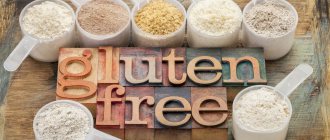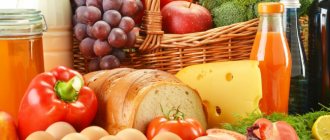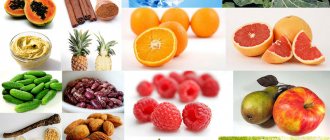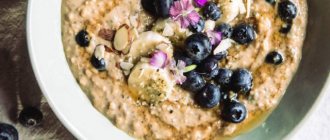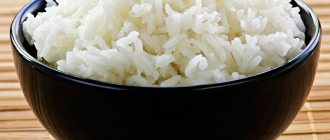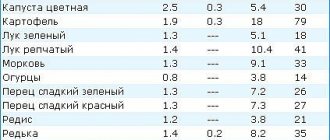Today you can often hear the expression “negative calorie foods.” But in reality this is not entirely true. Any food has energy value, and there is no negative calorie content. Then why do nutritionists and people interested in proper nutrition for weight loss talk so confidently about certain foods and their negative calories?
The fact is that the body spends energy on digesting food. Some foods require less work to be fully digested, while others require more calories from the body. Experts were able to find out that there is a food that contains fewer calories than are needed to digest it.
Negative calorie foods contain fewer calories than the energy required to digest them.
Such food is used for effective weight loss, because if the diet consists mainly of foods with the so-called minus calorie content, then weight gain is excluded.
Products that improve metabolism
Negative calorie list
Products containing a low glycemic index:
- Fish
- Seeds
- Nuts
- Eggs
- Meat
- Asparagus
- Beans
- Peas
- Soybeans
- Wheat groats
- Buckwheat
- Red rice
- Brown rice
- Beet
- Radish
- Eggplant
- Dill
- Parsley
- Tomatoes
- Cabbage
- cucumbers
The following list contains fructose, so the rate of absorption by the body is faster
Products containing an average glycemic index:
- Oranges
- Tangerines
- Grapefruit
- Mango
- A pineapple
- Cherry plum
- Kiwi
- Lemon
- Watermelon
- Melon
- Apricots
- Plum
- Pears
- Apples
- Berries
The Reality of Metabolism
Unfortunately, metabolism does not quite work in such a simplified way as chewing, digestion, in a word, assimilation. The number of calories you need per day is dictated by your body's basal metabolic rate. It can vary significantly from person to person, and metabolism can be fast or slow. But in any case, the metabolic rate is responsible for the energy needed to power all your vital systems and body functions at rest.
One of the components of energy that contributes to metabolism is the energy required to eat and metabolize food. However, it accounts for only 5-15% of the total volume.
For example, let's say your total calorie requirement for your body to function is 1600 calories, and only 80-240 calories per day will be used to metabolize all the food you eat. It is impossible to isolate from this number the number of calories used specifically for the absorption of, for example, celery or some greens.
In other words, these vegetables and fruits cannot be considered foods with minus calorie content, taking into account all the food mass that a person eats during a given day.
How to introduce it into your diet
- First of all, these products are recommended by nutritionists to get rid of extra pounds if there are signs of obesity;
- You should not completely switch to a low-calorie diet, completely abandoning all usual foods, this is stress for the body, to which it can react by reducing the metabolic rate;
- Greens, fruits, vegetables and berries will help saturate the body with the necessary minerals, trace elements and vitamins; they contain minimal amounts of polyunsaturated fats and animal proteins, so the presence of only such food cannot be made the basis of nutrition, only a supplement;
- To reduce your waist size without harming your health, add high-protein foods to negative-calorie foods - duck, chicken, fish, lean meat, turkey, seafood. The combination of these products along with physical activity burns excess calories well and leads to a slim figure;
- During the day you should consume 0.5 kg. vegetables and fruits, which accounts for 35% of the calorie content of the daily diet;
- During the day you need to drink at least 2 liters. water;
- Spices and herbs should be added to prepared dishes, and vegetables and fruits should be consumed fresh;
- Food should be subjected to a minimum degree of heat treatment, giving preference to fresh appearance;
- When preparing dishes, you need to use sunflower, mustard or olive oil, and not animal fats (butter, margarine);
- Try to steam food in its own juice as much as possible;
- Actively use yogurt for dressing fruit salads
- From time to time, eat your favorite foods, for example, 6 days of diet, and on 7, treat yourself to your favorite dish in small quantities.
Negative calorie foods: myth or truth?
Negative calorie foods are those foods that take more calories to digest than they contain. At least, there is a common belief that this is so, and that such products do exist.
It would seem that everything is logical. If 100 grams of white cabbage contains 27 kilocalories, then why can’t it take 40 kilocalories to chew and digest it, thereby creating a deficit of 13 kcal.
I’m revealing the truth about negative calorie foods – they don’t exist. It has been proven that the cost of digesting a product cannot exceed its calorie content. Moreover, up to 10% of their calorie content is spent on digesting, for example, vegetables. After all, why is cabbage so low in calories? Because it contains a lot of fiber and water. Fiber, in principle, is not digested, and therefore does not require caloric expenditure. “Digestion” of water is also part of the body’s basic metabolism, so it does not require additional costs. Carbohydrates contained in cabbage require only 5-7% of the total calorie content of this cabbage.
Still not convinced? Do you still think that vegetables and fruits may not add calories, but waste them?
Then imagine an experiment. Two people - two locked rooms. One is given only water to drink, and the other is fed foods with a negative calorie content - carrots, cabbage, radishes, mushrooms, etc. Who do you think will lose weight faster and “glue their fins together”?
Yes, the theory that you can eat and lose weight is beautiful and you really want to believe in it, but it is deceptive.
Myth or truth? Negative calorie foods: list for weight loss
Therefore, don't expect that you can eat a piece of cake and then a kilo of celery and thereby burn the calories from the cake, thanks to the negative calorie content of celery. Imagine this picture and smile)).
But, on the other hand, foods with very low calorie content do exist. They may not burn calories, but they will hardly add any calories either. For example, to get only 100 kcal from cabbage, you need to eat almost half a kilogram. And that's a lot! Therefore, the so-called foods with negative calories, or more correctly, foods with low or minimal calories, will really help with weight loss.
For convenience, and in order not to be confused, later in the article we will assume that negative calorie content, low and minimum calorie content of foods are one and the same.
By the way, you can find out how to count calories correctly if you read our article How to count calories correctly to lose weight.
Many vegetables and fruits can be classified as negative calorie foods. Below I will provide a list of vegetables, fruits and berries with negative calorie content in the form of tables.
Please note that all the vegetables, fruits and berries listed in the tables have virtually no fat, contain very little protein and some carbohydrates. Moreover, they consist of more than 80% water. This is what makes them so low in calories. And that is why their calorie content cannot be truly negative. Try to completely dry these foods, and their calorie content will immediately increase by 6-10 times. This once again proves that the caloric content of these products is not negative at all, but is simply greatly diluted with water.
For example, the calorie content of a plum is 43 kcal, but the calorie content of dried prunes is 264 kcal.
You can find a complete table of calorie content of foods on our website: Table of calorie content of foods.
What cannot be combined with
- You should not take smoked meats and fatty foods, as well as baked goods and confectionery products along with low-calorie foods containing negative calories;
- Do not add sugar to berries and fruits; this is a fast carbohydrate that promotes weight gain. Salads should not be dressed with mayonnaise or heavy cream, preferably low-fat sour cream.
- If you are a melon lover, consume it between meals and before 6 pm. This is a difficult product for digestion, if taken late in the evening or immediately after a meal, the stomach may experience a feeling of heaviness in the stomach. You should not drink it with fermented milk products or water; signs of diarrhea may occur.
Berries and fruits with negative calorie content (table)
In the table below, we have compiled a list of berries and fruits with negative (low) calorie content.
You need to be more careful with fruits and berries than with vegetables. Firstly, it is easier to eat a lot of them than vegetables, as they taste better. Secondly, they are higher in calories than vegetables, as they contain fructose. Nutritionists recommend eating fruits, mainly in the first half of the day. It is better to eat vegetables and protein in the afternoon.
| Product | Water, g | Proteins, g | Fats, g | Carbohydrates, g | Calorie content, kcal per 100 g |
| Apricots | 86,0 | 0,9 | – | 10,5 | 46 |
| Quince | 87,5 | 0,6 | – | 8,9 | 38 |
| Cherry plum | 89,0 | 0,2 | – | 7,4 | 34 |
| A pineapple | 86,0 | 0,4 | – | 11,8 | 48 |
| Cherry | 85,5 | 0,8 | – | 11,3 | 49 |
| Pear | 87,5 | 0,4 | – | 10,7 | 42 |
| Dogwood | 85,0 | 1,0 | – | 9,7 | 45 |
| Peaches | 86,5 | 0,9 | – | 10,4 | 44 |
| Garden plum | 87,0 | 0,8 | – | 9,9 | 43 |
| Apples | 86,5 | 0,4 | – | 11,3 | 46 |
| Orange | 87,5 | 0,9 | – | 8,4 | 38 |
| Grapefruit | 89,0 | 0,9 | – | 7,3 | 35 |
| Lemon | 87,7 | 0,9 | – | 3,6 | 31 |
| Mandarin | 88,5 | 0,8 | – | 8,6 | 38 |
| Cowberry | 87,0 | 0,7 | – | 8,6 | 40 |
| Blueberry | 88,2 | 1,0 | – | 7,7 | 37 |
| Blackberry | 88,0 | 2,0 | – | 5,3 | 33 |
| Strawberries | 84,5 | 1,8 | – | 8,1 | 41 |
| Cranberry | 89,5 | 0,5 | – | 4,8 | 28 |
| Gooseberry | 85,0 | 0,7 | – | 9,9 | 44 |
| Raspberries | 87,0 | 0,8 | – | 9,0 | 41 |
| Cloudberry | 83,3 | 0,8 | – | 6,8 | 31 |
| Sea buckthorn | 75,0 | 0,9 | – | 5,5 | 30 |
| White currant | 86,0 | 0,3 | – | 8,7 | 39 |
| Red currants | 85,4 | 0,6 | – | 8,0 | 38 |
| Black currant | 85,0 | 1,0 | – | 8,0 | 40 |
| Blueberry | 86,5 | 1,1 | – | 8,6 | 40 |
Foods that contain almost zero calories
There are many foods that have almost zero calories. They can significantly improve your metabolism, thereby helping you lose weight effectively. These foods are typically plant foods that are high in water content and rich in fiber: grains, legumes, vegetables and fruits, excluding fatty fruits and vegetables such as avocados and olives. As your body puts in more effort and time to burn fibrous foods, your metabolism continues to stay elevated, propelling you toward weight loss. Start by adding these foods to your menu.
If you're trying to reduce your overall calorie intake, a few standouts from this group will enrich your diet without adding extra calories. Let's look at the table!
| № | Name | Photo | Number of calories in 100 grams |
| 1 | Apples are the most popular fruit all over the world. | 48 | |
| 2 | Beets are a dark red or purple root vegetable that has the ability to lower blood pressure. | 46 | |
| 3 | Broccoli is a cruciferous vegetable that is essential in the fight against cancer. | 34 | |
| 4 | Brussels sprouts - resembles mini cabbages, can be eaten raw, high in vitamin C. | 43 | |
| 5 | Cabbage is a white and purple leafy vegetable that is high in vitamin K. | 27 | |
| 6 | Carrots are very rich in beta-carotene, a supplier of vitamin A for good vision. | 41 | |
| 7 | Cauliflower is a popular substitute for high-carb vegetables and grains. | 30 | |
| 8 | Celery is the most famous low-calorie food and contains insoluble fiber. The roots, stems and leaves are eaten. | 14 | |
| 9 | Cucumbers - 90% of the vegetable content is water. | 15 | |
| 10 | Grapefruit contains a complete set of vitamins and microelements. Reduces cholesterol levels and speeds up metabolism. | 35 | |
| 11 | Leaf lettuce is rich in vitamin K, vitamin A and folic acid. | 16 | |
| 12 | Lemons and limes are essential antioxidants in the fight against oxidative stress. | 33 | |
| 13 | Porcini mushroom is a vegetable protein, a meat substitute. | Raw—34 Boiled—28 | |
| 14 | Onions - a huge variety of species, are indispensable in cooking. | Raw—44 | |
| 15 | Bell pepper is a rich antioxidant and cannot be replaced in the fight against oxidation in the body. | 26 | |
| 16 | Radishes are a crunchy root vegetable with a savory flavor. | 20 | |
| 17 | Strawberries are a great berry that protects the body from cancer and heart disease. | 41 | |
| 18 | Spinach - Rich in vitamin K, vitamin A and folic acid, it contains more protein than some other leafy vegetables. | 23 |
Negative calorie supplements
What it is? There are some biologically active compounds that have been found in foods that speed up metabolism, and there is laboratory evidence for this. These are, for example, naringin and synephrine - in grapefruit.
Synephrine is a plant substance that belongs to the alkaloid group.
Naringin is a plant flavonoid, a citrus antioxidant.
But is it possible that these compounds could increase metabolic rate enough to induce a calorie deficit and therefore reduce body weight?
In fact, the reality is this. Supplements that actually increase metabolism, such as caffeine, have little effect on calorie burning. Therefore, a supplement that helps burn the extra 12 kcal will not be significant in the overall weight loss process.
So, the bottom line is that supplements that increase your metabolic rate have a short-lived and insignificant effect.
Protein products with minus calorie content - eat and lose weight
This group of products includes all types of lean meat, poultry without skin and fat (preferably breast), and lean fish . It is recommended to steam or boil meat and fish (do not eat broths), and take salads from fresh vegetables and herbs, which we wrote about above, as a side dish. The presence of fresh vegetables and herbs in the menu with protein products is mandatory, otherwise there will be no weight loss effect. Nutritionists recommend giving preference to fish because it has unique fatty acids that are beneficial for muscles, skin and blood vessels. In addition, when fish is digested, no gases or toxins are formed in the body, which has a beneficial effect on the overall well-being and appearance of a person - the skin acquires a healthy shade, becomes more elastic, and gets rid of facial wrinkles.
Celery and asparagus
Did you know that eating asparagus as a side dish at least once a week prevents the formation of cellulite? If not, you can go to the store for it, especially since it costs only 20 calories, which are completely spent on processing the product by the body.
Celery is not just a source of coarse dietary fiber and one of the most beneficial plant species for human health. This is also a product with a negative calorie content - only 12 units per 100 g.
